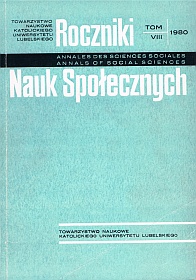Dahrendorf’s Theory of Conflict in the Industrial Society
Abstract
The article sets out to present Duhrendorf’s theory of conflict and show some difficulties in interpreting it as regards both content and method. In presenting the characteristic feaures of industrial societies Dahrendorf demonstrates the inadequacy of functional theories, which do not take sufficient account of the role of conflicts that are so common in those societies. An analysis of the conflicts requires modification of the model that locates them in the sphere of property. According to Dahrendorf, property is a special case of power relations, which are the ultimate conflict area. The organization of life in industrial societies is based on specialized roles being played in hierarchical power structures. The roles arc the basis on which mutually opposing interest groups are formed. The groups, however, differ from classes as defined by property criteria, since power relations tend to become autonomous. Furthermore, the conflict becomes institutionalized as regards both its outward forms and the methods of resolving it.
Methodologically, this model of conflict proves to be too general for the properties of conflict to be differentiated or for its dynamics to be analyzed. In particular, the postulated category of covert interests that arise from the objective situation of an individual playing a specific role in a given social structure separates sociological analysis from the everyday experience of individuals, who are the genuine animators of conflict. As regards the method of analysis, Dahrendorf does not go beyond the broad framework of a functionalistic and positivistic model of science. He underestimates the fact that social structure is constituted in the sphere of meanings, on the basis of socially formed rules of language use.
Copyright (c) 1980 Roczniki Nauk Społecznych

This work is licensed under a Creative Commons Attribution-NonCommercial-NoDerivatives 4.0 International License.


